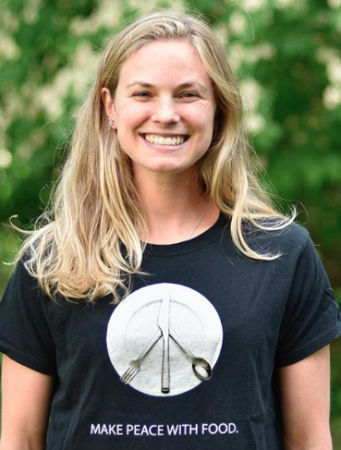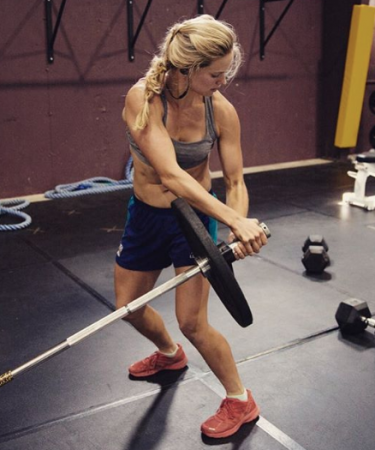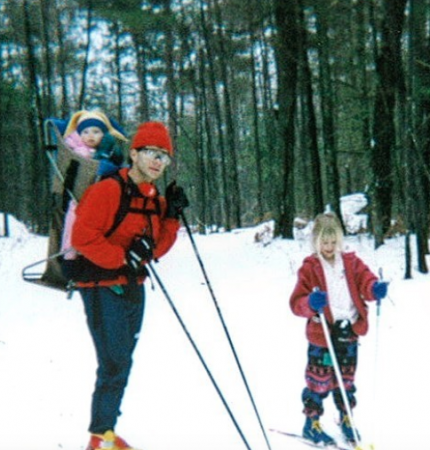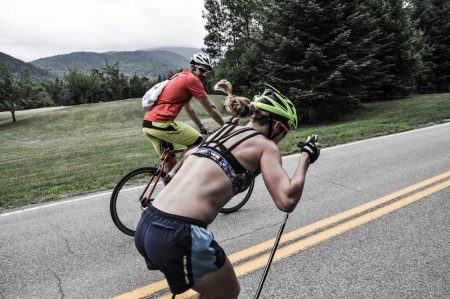After appearing in ESPN’s Body Issue in June 2018, Jessie Diggins shared an impactful blog post, opening up publicly about her history of struggling with bulimia. In this raw piece, she shared how her perfectionist mindset coupled with the stress she was putting on herself in all areas of her life snowballed in her senior year of high school. Those pressures triggered her to turn to an eating disorder as a coping mechanism to help her feel a false sense of control in her fast-paced life.

Since her post revealing her struggle with an eating disorder, Diggins has partnered with the Emily Program, the national leader in eating disorder treatment where she found the help she needed. Diggins now features the Emily Program logo on her headgear and has shared a deeper look into her recovery story through blog posts and the program’s podcast, Peace Meal.
FasterSkier connected with Diggins during her recent stint at the Snow Farm in New Zealand to take a deeper look into her journey through the phases of eating disorder recovery. We also examined the tools she employs to create healthy outlets for stress, and how the climate surrounding body image and mental health has changed during her time on the National Team.
Stepping back to the beginning, 17-year-old Jessie Diggins was a high achieving kid. As one might expect, she was not content to limit her focus solely on cross country skiing; she held herself to a high standard in all areas of her life. This Type-A wiring is often seen in endurance athletes and can be beneficial when it comes to following a training plan, analyzing progress, and creating a healthy routine that supports an athlete’s development.
But, the predisposition for a relentless focus on routine and excellence can also be a precursor for an eating disorder. As the saying that resonates with Diggins goes, “Genetics loads the gun, environment pulls the trigger.”
“I put so much pressure on myself to get perfect grades, and to win all the races and to do all these extracurriculars in school,” Diggins recalled. “And all this came to a head [my senior year] which is what kicked off my eating disorder.”
As Diggins evidenced, it is a misconception that eating disorders are solely about attaining a certain look, weight, or size. Though negative body image certainly plays a factor, they are an unhealthy coping mechanism to escape other stressors in a person’s life.
“Bottom line, it wasn’t really about food or about being lean for sport, it was about that feeling of ‘I have to be perfect or else I will probably just die. The world is going to end.’”
It was at this point that Diggins began “using symptoms”, the terminology used in the realm of treatment to describe the unique behaviors associated with one’s disorders. Behaviors classified as symptoms for one might not be labeled as such for another. Diggins’ symptoms included restricting her food intake by gradually eating less and less by a margin that was outwardly difficult to detect, and purging by adding workouts outside of her normal training like a run after dinner and also making herself throw up. Because her disorder provided a feeling of control, she could not see that these symptoms were self-harming rather than supportive of her trajectory as a skier.
“Your eating disorder kind of hijacks your brain and makes you think, ‘No, I have to do this. This is totally going to work for me. This is part of my path to success.’”
At first, as is commonly seen, Diggins did experience an increase in performance as her weight dropped, briefly increasing her power-to-weight ratio. But that improvement was short-lived as the effects of chronic malnourishment began to take effect. Diggins also entered a downward spiral of negativity surrounding her self-worth and sense of pride in her accomplishments.
“In the short term, I did have success, and yet I didn’t,” she recalled. “I was so unhappy — no race could make me happy anymore. Before, whether or not I was winning, it was just the simple feeling of, ‘I really pushed myself hard.’ That for me was great and I used to be able to feel that sense of pride in a job well done. With my eating disorder as this voice in my head, nothing gave me that pride anymore because all I ever heard was, ‘You’re too fat. You’re too slow. That wasn’t good.’ It was such a negative thing and it was as though my eating disorder was this thing that would attack every part of my performance.”
She described this time in her life as “brutal” as she felt defeated, yet unable to talk about what she was experiencing with anyone. Though her performances were still strong relative to her peers, she was racing far below her potential.
“I can say that because once I started fueling myself properly again, [my performance] just rocketed up to the next level. So even though I thought I was doing fine in the moment and I was thinking that this is probably as good as it gets, as soon as I started fueling well, I went from winning maybe one Super Tour to winning all of them the next year.”

As it is a complex mental disorder, the mindset of someone in the throes of an eating disorder can be difficult to understand for those on the outside. In Diggins’ case, it was as if her disorder had its own being, telling her what to do and robbing her of her joy. She described it as being akin to being trapped in an abusive relationship.
“You feel like you need this thing and that you’re better off with it even though you know it might kill you someday and you just feel like you can’t get out of it. It was like I was married to my eating disorder in that way where it was definitely going to kill me someday, there’s no bones about that. No one really survives a healthy life with an eating disorder.”
At this point, it has been nearly ten years since Diggins checked herself in for a two-month intensive course of treatment at the Emily Program after her senior year of high school — help she sought after a gentle confrontation by her concerned parents. While Diggins explained that this day program jump-started her journey toward recovery, her actual healing occurred through years of work and therapy. Though she no longer feels compelled to use symptoms, Diggins recognizes that she must remain cognizant of her self-destructive tendencies.
“Similar to if someone has a drug addiction or alcoholism, it’s not like, ‘Oh, you’re cured. You never have to think about this again ever.’ That’s just not realistic. You’re always going to have something you have to protect yourself against and maybe it’s something that you really struggle with, maybe it’s something in the far corner of your mind. It’s different for different people. There’s no one roadmap to recovery.”
Diggins likened the recovery program she began to a “boot camp for training”, where one works intensely to start getting back in shape. Just like in sport, this boot camp might develop some basic fitness, but it is not the ticket to athletic prowess.
“Going into it, I was like, ‘Great! In two months, I’ll be totally good.’ And that’s just not how it works. You can’t just train for two months in skiing and be like, ‘Cool, now I’ll win all the races.’ It just doesn’t work that way.”
The primary goal of the treatment program at the Emily Program was for Diggins to get to the root of her disease by identifying why she felt compelled to use symptoms in the first place.
“That is the hardest work that you have to do because you have to be ready to face whatever emotionally is going on that has led you to a place of having an eating disorder. For me, it was about stress and I felt like I had to be perfect all the time and I had such high standards for myself that there was a lot of anxiety. I felt like it was totally black and white, all or nothing, there was no grey area, which life isn’t like that.”
Throughout her two months at the Emily Program, Diggins was able to continue her ski training. Although, her workouts were moderated to ensure her training was productive and targeted with her athletic development in mind rather than supplemental workouts that might be influenced by a need to burn more calories or escape the emotional toll of her therapy. As she explained it, she worked with her therapy team and coaches to determine what workouts were “symptoms” and what was her “normal” training load as a high-level athlete.
“It’s important to define it that way because the way we train for cross country skiing, if I wasn’t an athlete, that would be a symptom — overexercising. Since I was following a training plan, it was just doing normal training, but if you weren’t an athlete and all of a sudden you were doing two-a-day workouts that were super long, that would maybe be classified as a symptom. So it’s important to figure out what is your ‘normal’, what’s within that realm, and what are you doing that is not normal that your eating disorder is making you feel like you have to do.”
As time went on, Diggins began to see a glimmer of hope that a healthy and successful life after her disorder was possible and her recovery process accelerated along with her speed on skis.
“That’s when I was able to start committing to recovery. While I was really sucked into my eating disorder spiral, I couldn’t see that I was better off without it. But what the Emily Program did was help me realize, ‘Nope. It’s still going to be a lot of work to separate yourself from this eating disorder.’ But you’re finally able to see, ‘Oh yeah, I don’t need this to survive. In fact, I’m better off without it and now I’m ready to do the hard work.’”
Diggins therapy helped her recall a time before her eating disorder “hijacked her brain”. This process allowed her to reflect on the positive body image she had as a child, and to believe that a return to this state was possible.

“At one point I was fine without it, at some point again, I will once again be fine again without it. So it’s about having that trust.”
She came to recognize that she was using symptoms to numb the anxiety and stress that she felt from the pressure to be the best in all areas of her life. With the help of her therapists, Diggins began to create a toolbox of alternative positive coping mechanisms to replace these self-destructive tendencies. She also worked to be more forgiving of herself, rather than focusing on perfectionism.
“That takes time — to build those tools, to create those tools, to realize what tools actually work for you and what doesn’t. Figuring out, what are the things that work for me? Then trying to recircuit your brain so that when that eating disorder voice is screaming at you to use symptoms, instead you can say, ‘Nope. I’m going to use this tool instead.’”
Some of the strategies that worked for Diggins include taking a walk, practicing yoga, or talking to her mom or a friend on the phone. Though seemingly simple, changing her habits and mindset to override the voice of her disorder and default to these coping mechanisms. She also focused on creating a more positive inner dialogue to undo the damage of the eating disorder’s deprecation.
“Something that really helped me when I was in recovery was to pretend that you could look back on yourself as a three-year-old child. You would never turn to yourself as a three-year-old and say, ‘Oh my gosh. You’re so fat and you suck.’ You’d never say that to any child and hopefully, you would never say that to yourself. Just because you’re an adult, why should you get to say terrible things to yourself?”
After the two-month program, Diggins felt a distinct separation from her disorder and had identified a reliable set of tools to practice using in recovery. That is not to say the work was completed. Her recovery entailed repeatedly taking a few steps forward followed by a step back to slowly distance herself from her past.
“When I left the Emily Program, I went back on the road with skiing and it wasn’t like it was just perfect and fine and easy. It was sort of celebrating streaks of days that I didn’t use symptoms. At first, it was ‘I didn’t use symptoms for a whole day. That’s so great!’ And then something stressful would happen and I would use symptoms and I would start my streak over again. Then I would not use symptoms for a week and it would be a really big deal.
“Basically, the timeline between using symptoms would get longer and longer, so then I would be able to go a month or two or even half a year, and eventually, it got to the point where I can be like, ‘Oh my gosh. It’s been years since I’ve used symptoms.’ And that happened gradually over a five-year period where I became healthy and confident enough to always choose the non-self-destructive path.”
By the time her World Cup ski career began to take off, Diggins had developed the self-confidence and awareness to push out negative thoughts and behaviors, for which she expressed gratitude as her life — and body — became increasingly subject to public scrutiny.

“Thankfully, by the time I got to the Olympics, I couldn’t even remember the last time I had used symptoms, which is good because I was faced with probably the most stress I have ever had in my life. The entire country is watching your body in a spandex suit and feeling like they had the right to comment on it. That is maybe the worst nightmare for someone who has had an eating disorder. However, it had been so long since I had used symptoms, even if something happened or someone said something to me and I felt that voice of my eating disorder come up again and say, ‘You know what you should do? You should use symptoms?’ I could tell the voice ‘No’ and choose to do something healthy for me instead.”
In her tenth year of the recovery process, her time at the Emily Program and her dependence on her eating disorder are increasingly distant for the 28-year-old. But, as she expressed, she will always need to remain on guard against her disease. To remain both accountable and supported, Diggins has created a support network around herself which includes her family, friends, and coaches.
“I have a really open relationship with all of my coaches. All the coaches on the National Team know my history and I feel like I could go up to any of them and say, ‘Someone said something to me and it’s really making me feel terrible and I need a hug. Or I need you to tell me what I did well in practice today so I can have something good to think about.’’
Amidst 20-plus hour training weeks and an always-on-the-go lifestyle, the idea of maintaining a feeling of balance and avoiding the pileup of stress seems as challenging as the training itself. Diggins explained that since she has become accustomed to this lifestyle and load, it does not make it more challenging for her to feel at ease or maintain her separation from the disorder.
“The training I do now as an almost 28-year-old is pretty extreme, but my coach, [Jason] Cork and I make the plan, and it has been bumping up very gradually every year for the last ten years. It’s not like I just jumped into this. For me, this is actually normal and we can look at years of data and say, ‘Alright, this is within the realm of what we know your body absorbs.’ And we keep close tabs on that. I have this thing in my training log where every day I rank how tired I am, my mood, how well I slept, how much life stress today. We really track that and make sure that if we need to back down on training, we are. So I think that’s something that helps keep me balanced.”
She continued that she also works with a sport psychologist weekly during the winter when the stress and pressure are highest, but also meets with her during the summer.

“We set concrete goals that have nothing to do with results and nothing to do with what you look like or what other people think about you. The goals are like, ‘This New Zealand Camp, I’m really going to stay hydrated because it’s dry at altitude and it’s wintertime so you dry out faster. I’m really going to work on dialing in kick wax during these races.’ Goals that have nothing to do with your professional success, but have everything to do with it because if you meet those goals consistently, they add up to a really awesome product at the end. But having goals that keep you grounded with small attainable steps is really what helps me in life to stay more balanced.”
This concept of focusing on smaller process-focused steps rather than the larger more intimidating goal has been essential in both her athletic career and her recovery journey.
“If you look at the big picture, it’s like, ‘Alright. I’m going to try to win a gold medal at the Olympics.’ And it’s like, ‘Oh man! That is a really big goal. That is really stressful.’ But if you break it down and then all of a sudden you’re like, ‘This week, all I’m going to focus on is a few key intervals and really staying on top of hydration and maybe taking a nap every day.’ That’s not hard, and it makes you feel like you’re taking steps toward the big goal without stressing out from thinking about the big goal all the time.
“It’s like my recovery from my eating disorder as well. Every week, there were small goals. It was never like, ‘Okay I’m never going to use symptoms again.’ That’s like the gold medal goal. There were all these smaller goals, like, ‘This week, I’m going to resist using symptoms at least three times and I’m going to use these three things to distract myself so I don’t use.’ Just tiny little steps where you could celebrate those wins along the way because you’re not going to get the big goal right away. I think that applies to anything in life, but especially in the realm of athletics or something really daunting and scary like recovery from an eating disorder or any addiction. It’s so important to have those little goals and to have people to be accountable to.
Diggins also works with a nutritionist regularly to make sure that she is meeting the energy demands of her training and to ensure that disordered habits are not sneaking in to prevent her from fueling optimally.
“I’ve worked for eight years with Susie Parker-Simmons at the USOC. I started working with her when I got on the US Ski Team. She’s been awesome because a lot of it is figuring out strategies for how not to get sick, how to boost your immune system, or you’re flying to a country where the food might mess with your stomach. All that sort of stuff. So it’s also very practical, but obviously, she understands pretty much everything about eating disorders and it was really helpful to have one more person on my team who knew my history and what was going to be challenging for me. And it was one more person who I knew was rooting for me and that I could be accountable to.”
Apart from her own progress, Diggins has seen progress in the overall climate surrounding body image and healthy eating habits in the sport as a whole. She attributes some of this to the increasing number of positive role models for young girls in the sport.

“Part of it is, we never used to have that many female coaches, and that can be really hard for a young girl in sport. I think the more women we have in leadership roles, the easier it may be for young women in particular to say, ‘Am I good enough the way I am? I need to talk to you about this.’ It might be easier to open up.”
Diggins recalls initially not feeling comfortable opening up to her father, let alone her male coaches about her struggles with body image and self-worth when she was in high school.
“I love all of the coaches I’ve had. They have all been there for me as a friend, as a mentor, sometimes as a second parent. But it can be really hard for a seventeen-year-old girl to want to go talk to a man about not feeling great about her body. That’s just hard.”
She also attributes the improvement in tackling this issue to the increase in educational resources for coaches about eating disorders and the risk factors. Diggins recalled that when she was trying to qualify for World Juniors, there was not much information available. She expressed that this lack of awareness and understanding might make coaches less inclined to confront an athlete who they might be concerned about as they may not feel qualified to support that person or to connect them with appropriate care.
“How do you talk about something that you don’t understand? There’s just not enough educational materials out there. The mode of thinking at the time was, ‘If we just don’t talk about it at all, maybe it won’t be a problem?’ It obviously came from a place of good intention, but there just wasn’t enough information available.”
In Diggins’ view, this lack of discussion contributes to the pervasiveness of eating disorders in endurance sports as it may inhibit someone who is struggling from asking for help.
“If it’s not talked about, then it becomes taboo, so then someone like me starts to have a problem and you feel like you really can’t tell anyone because now it’s this dirty little secret and I’m the weird one. When in reality, I don’t think I have met a person on this planet who hasn’t at some point exhibited either some signs of disordered eating or poor body confidence. It’s a universal human experience to at some point feel somehow dissatisfied with the body that you’re in.”
Overall, Diggins expressed that the climate and awareness about body image and disordered eating issues in cross-country skiing have improved since her time as a junior looking up to teammates that were trimming fat off of their meat at dinner and passing on hot chocolate. She also expressed that the dialogue about these issues is significantly more open and positive.
“I think we’re getting to a point where if some athlete is feeling like, ‘I feel like maybe I’m supposed to be skinnier. I don’t know.’ Hopefully, they can go to their coach and say, ‘Okay. So I’m kind of worried about my body shape. Can we talk about this?’ And the coach can say, ‘Hey. I don’t feel like I’m qualified. Let me refer you to someone. I really care about you and I support you, let’s figure out who your person is. Thank you for trusting me enough to tell me that. I want to help you out.’”
For coaches who are interested in learning more about how to create positive and supportive dialogue on their teams or to express concern for an athlete who might be struggling, Diggins recommends utilizing resources from the “What to Say Initiative” launched by the WithAll Foundation, a nonprofit that focuses on advancing eating disorder support and prevention. She explained that though a coach cannot cause an eating disorder in an athlete, research suggests that the language used by prominent adults in a young person’s life can greatly influence that persons’ body image, self-esteem, and likelihood of developing an eating disorder.
“If you are primed to have one, you have the right brain wiring, maybe you’re super type-A, maybe you’re stressed out, maybe something happens in your life to set it off. It’s really important that adults who are in a position where they’re overseeing kids are aware of what they’re saying and what words they’re using.”
The What to Say Initiative offers coaches age-specific phrases to incorporate into their dialogue with their athletes to support healthy physical and emotional well-being. There are also tips for how to use these phrases naturally in conversation and prompts to spark self-reflection in the language that is already being used with the team.

“You see athletes, especially in a sport like cross-country skiing, that are finding success on the World Cup in every body type. As a coach, you want to encourage athletes to celebrate the body that they are in and to know that they can find success in whatever their genetics has determined their body to look like.”
For anyone currently struggling with body image or disordered eating, Diggins recommends reaching out to the Emily Program through their hotline (866-673-8652). You will immediately be connected with a representative who will conduct a brief evaluative questionnaire to determine what level of care would best suit your individual needs. Additional information and resources are available at emilyprogram.com.
Rachel Perkins
Rachel is an endurance sport enthusiast based in the Roaring Fork Valley of Colorado. You can find her cruising around on skinny skis, running in the mountains with her pup, or chasing her toddler (born Oct. 2018). Instagram: @bachrunner4646



